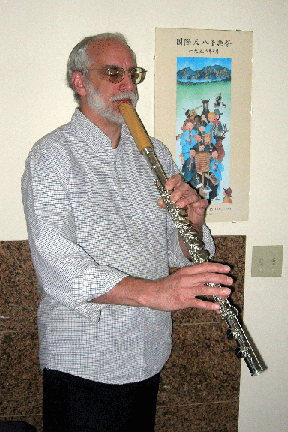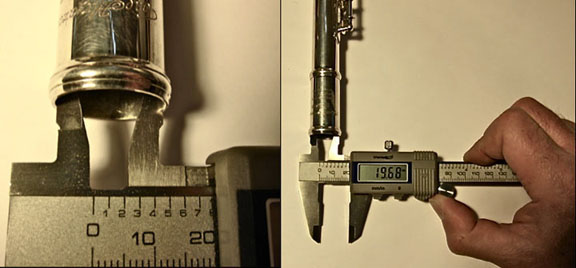 |
for the Silver Flute (Frequently Asked Questions) |
 |
for the Silver Flute (Frequently Asked Questions) |
(1) Will it be easy to insert and remove the new shakuhachi headjoint from my silver flute body? Can I switch from transverse to vertical modes quickly and easily or do I need a devoted flute for each headjoint?
The shakuhachi headjoint slips on and off exactly like your transverse headjoint, sliding quickly and easily into the flute body socket. The two are totally interchangeable and replaceable in seconds. One flute works for both headjoints. The only difference is when playing the instrument vertically, a thumb rest is recommended. I have designed a simple and elegant rest that clips onto the lower part of the flute body without scratching or otherwise damaging it. Two thumb rests are provided with the headjoint at no additional charge.
(2) Will it more difficult to finger my flute when it is held vertically?
Ergonomically, the effect of holding the flute vertically is much less stressful on your hands , wrists, arms, shoulders and neck than holding it horizontally. This is one of the main advantages of using the shakuhachi headjoint. Even the longer alto Shakulute is easily played. Similar to longer, lower keyed traditional shakuhachi, the second joint of the right index and ring fingers are used to operate the B and C keys on the alto. All the other keys are played using the finger tips.
(3) Is learning to produce a sound on the shakuhachi headjoint more difficult than the transverse flute?
Over the years, I have noticed that, while the shakuhachi embouchure is unique to this traditional instrument, players with experience on the Western silver flute adapt to it quite readily. Attending the National Flute Association conventions, I am impressed with the facility of so many folks who had never before picked up a shakuhachi. That being said, the instrument does make its own demands and will require practice in order to produce a strong resonant sound. Many players have commented that the shakuhachi headjoint is actually capable of creating a noticeably "bigger" sound than that of the transverse headjoint. Given the broader width of the shakuhachi blowing edge, this comes as no surprise.
Consulting one of the shakuhachi playing guides I have available may be helpful. While most of these resources go into depth in matters peripheral to the Shakulute, all of them touch on the issues of embouchure and how to produce a good sound. I would recommend, in particular, Bruce Huebner, KINKO SHAKUHACHI FOR BEGINNERS: A Video Lesson in English (Vol. 1). It is available on DVD or VHS and enables you to see how it is done.
(4) Is it possible to adjust the frequency of the shakuhachi headjoint above or below A=440 hz.? Will I be able to compensate for pitch when playing with other instruments?
Adjustment for pitch is built into the design of the Shakulute. The overall length of the headjoint has been precisely calculated to enable the player to vary pitch by slightly increasing or decreasing its depth into the flute body socket. This will enable you to fine tune your flute when playing with other instruments or accommodate it to changes in ambient temperature. The pitch of the flute is somewhat affected by air temperature of the room in which it is being played. At 20 degree C. / 68 degrees F. the end of the tenon should be positioned about 5 mm. (3/16") from the bottom of the flute body socket. For an exact determination, you will need to use a digital pitch meter.
Also bear in mind that the Shakulute headjoint tenon is purposely sized to be a bit tighter than a transverse headjoint. When playing the flute vertically, pressure is applied to the end of the headjoint that would otherwise cause it to be pushed into the flute body socket.
(5) Would the mouthpiece-to-keys distance be about the same for the Shakulute and transverse headjoint?
Not quite. In constructing the shakuhachi headjoint to produce the same pitch as the transverse flute, the distance from the utaguchi (shakuhachi blowing edge) to the keys is just a bit longer than the blow hole of your transverse headjoint. This distance, however is very slight (less than 3/4"), has no effect at all on fingering and is the same for instruments with either a C or B footjoint.
(6) How does the sound produced by an instrument using the shakuhachi headjoint compare to that of the classical side-blown flute?
The first thing many players notice is that the Shakulute produces a particularly large envelope of sound with enhanced volume and power. This has much to do with Tai Hei Shakuhachi's unique redesign of the traditional mouthpiece. A wider surface along the blowing edge shaped to the proper depth and curvature helps to establish a strong and full initial vibration of the resonating air column inside the flute body. Internal dimensions and acoustical design of shakuhachi headjoint also helps to enhance both resonance and the harmonic configuration of the sound it produces.
(7) What is the range of the Shakulute?
The range of the shakuhachi is 2 1/2 octaves, covering all of the notes in the traditional repertoire. The same holds true for the Shakulute. Tanifuji Kozan is grandmaster of the shakuhachi (Tozan-ryu) in Japan, and now the premiere Shakulute virtuoso in the country. He mentioned that it is very difficult for someone starting out on the�Shakulute to sound stable tones in high range, especially over G in the 3rd octave, because the edge of the headjoint (utaguchi) is sharper than the Western flute mouthpiece. However, he was able to achieve these higher notes after after working with the instrument for a while by modulating his embouchure.
(8) Should I be concerned about the bamboo headjoint cracking?
The propensity of wood and bamboo to crack is generally associated with changes in temperature and humidity that cause the material to swell and shrink, thereby weakening the bond between its fibers. This concern has been address by having the headjoint bound at three critical places on the standard flute headjoint and four on the alto in the manner used by traditional shakuhachi makers.
In applying inlaid rattan binding, a channel is first chiseled in the bamboo. Binding is tightly wrapped inside this groove which is then glued and carefully filled to within a fraction of a millimeter below the surface of the bamboo. This space is inlaid with finely-split rattan evenly to the outside of the instrument. The visual effect of the rattan is quite beautiful and the deep inlaid binding provides added tensile strength to counteract any movement of the bamboo. Inlaid lacquered and standard binding are also available and more affordable options. Click here for complete information abut binding styles and types.
Furthermore, the bamboo of the headjoint is virtually welded to the solid silver tenon in a special casting process to assure that the two materials have a common coefficient of expansion.
(9) How can I be certain that the shakuhachi headjoint I order will fit perfectly into my silver flute body socket?
To size the headjoint to your flute body socket, it is necessary for me to have in hand a transverse headjoint that fits your flute or the instrument itself. To achieve an optimum fit, the tenon must be sized very precisely to within less than a of thousandth of an inch. Standards for socket diameters vary with each manufacturer and even amongst instruments made by the same company. Thus, each headjoint requires a custom precision match to your particular flute. I have all the tools on hand to do this and there is no extra charge for the service.
If you are prefer not to send a flute or transverse headjoint, it is possible to have a local band repair person do the sizing. It's a fairly simple procedure and avoids the necessity of having to ship your flute or headjoint. Another alternative is to use Tefon, scotch tape or paper shims. While not as elegant, this method allows you to use the headjoint on multiple flute bodies of different sizes.
In either case, it would be helpful for me to have a precise measurement of your flute body socket's inside diameter. This will allow me to make a Shakulute headjoint using a tenon that comes closest to your instrument and reduce the amount of adjustment required. Measurement can be done using a digital vernier caliper, a tool that is relatively inexpensive and commonly available.

(10) Can the shakuhachi headjoint be made to work on more than one of the flutes I own?
Having the headjoint tenon sized to a flute with the smallest diameter socket will allow you use it on any instruments with a larger socket. Simply use Teflon, scotch tape or paper shims to insure a proper fit.
(11) What would be the timetable for making the shakuhachi headjoint?
I usually have most models in stock. If not, I would begin work immediately and have it ready for fitting within a week or so. Once you send me your flute or transverse headjoint to measure, I can have your order completed and shipped within two days.
(12) I would like to order a Shakulute, but do not presently own a silver flute? Are complete instruments available?
Yes. I am presently have Miyazawa professional-quality flutes as well as Gemeinhardt and Trevor James professional and student-level instruments for sale on special order. Click here for details on pricing and availability. See a listing of Shakulute headjoints complete with a silver flute currently available for sale.
THE SHAKULUTE Shakulute Home Page |
Japanese Web Site |